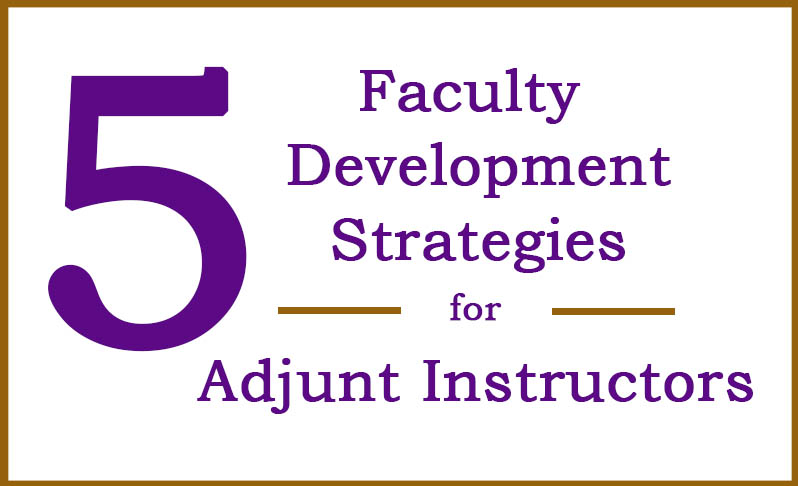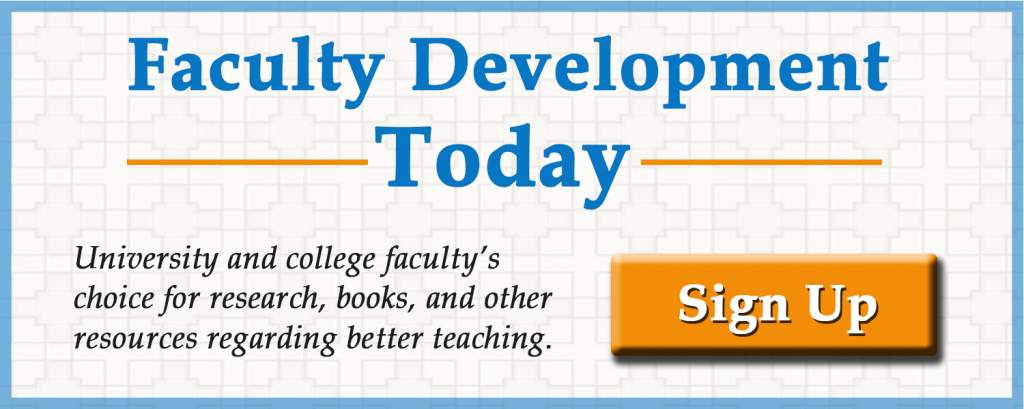Adjunct instructors are the fastest growing population of faculty in the academy. (Tweet this quote.) Given the current economic condition and its impact on institutions of higher learning, the proportion of adjunct faculty is likely to increase. Yet the adjunct population continues to remain disconnected from the academy, as few institutions have yet to dedicate the time, resources, and communication channels necessary to support their work. Paradoxically, at the same time institutions are becoming more and more reliant on this contingent labor force.
Few researchers have investigated the motivations, preferences, and barriers that exist for adjunct instructors who wish to participate in professional growth opportunities. To usher in the paradigm shift needed to professionalize development opportunities for this critical population, adjunct instructor voices and perspectives must be a part of the research design.
Key Development Strategies for Adjunct Instructors
In a recently published article in The Journal of Faculty Development, B. Jean Mandernach, Emily Donnelli-Salle, Virgil Rusty Norris and I offer strategies based on research involving over 600 online adjunct instructors and propose recommendations for institutionalizing faculty support based on these findings.
In revisiting the research question formulated for our research, “What do online adjunct faculty perceive as the greatest motivators and barriers to engagement in professional development?”, the analysis reveals three main conclusions:
- online adjunct faculty are motivated both intrinsically and extrinsically by multiple factors,
- primary barriers to professional development include a lack of time, program scheduling, or a lack of interest in programming,
- opportunities perceived as optimal are asynchronous, allow for independent completion, and are regularly offered through the department or distance learning center.
More specifically, we found:
- Intrinsic motivation is key for adjunct faculty. While existing research may suggest both intrinsic and extrinsic factors contribute to motivation to participate in professional development, findings from this study revealed that the majority of participants (78.8%) were intrinsically motivated to engage in professional development. Such intrinsic motivation included the desire for professional growth and the opportunity to improve teaching effectiveness.
- Economic incentives remain strong. Against the backdrop of these factors stands the strong motivation provided by economic incentives (64.7%), including pay increases, course scheduling priority, and retention. Hence, the findings suggest the dual importance of intrinsic and extrinsic motivations, mitigated by practical considerations related to awareness of professional development opportunities and access. Respondents prioritized pragmatic features such as delivery format, modality, and scheduling alongside the desire for programs which respond to their personal interests, enhance their teaching and professional growth, and which foster collaboration and connection to a broader academic community.
- Adjunct faculty require a special brand of professional development. (Tweet this quote.) Research has demonstrated the value of promoting self-directed learning among professionals; similarly, the benefits of on-demand resources for online professional development were evident in our results. Not surprisingly, asynchronous, platform-independent development opportunities that can be accessed “on demand,” and to which adjunct faculty can return for reference, reflect the professional realities of adjunct faculty – many of whom teach at multiple institutions (44%) and balance full-time positions outside of academia. (Tweet this quote.) Self-paced online short courses, static multimedia presentations and self-paced online modules place the greatest amount of control and scheduling in the hands of the instructor and combat the highest reported barriers to participation: scheduling and time. Despite the popularity of call-in or web-based synchronous professional development workshops, adjunct faculty reported the least preference for these formats.
- Engaging adjunct faculty in meaningful development is still important. Such practical concerns, however, may not hold as much sway as faculty developers may assume. As the data showed, while the majority of respondents (74.4%) indicated preference for asynchronous faculty development formats, almost a quarter (22.6%) of online adjunct faculty respondents indicated no strong preference for or against the various faculty development venues. This high rate of non-committed perspectives suggests that devising innovative and accessible faculty development programs is matched in importance by attention to other motivational factors, such as offering topics of interest which engage participants in meaningful development of their teaching practice.
- Awards and other recognition are not as important. Compensation for training, salary increases, job security, and control over one’s schedule are tangible outcomes valued significantly above faculty development awards and other forms of institutional recognition, independent of type or platform of programming. This finding may place a check on the tendency of institutions to rely on teaching awards as a central mechanism for demonstrating recognition of adjunct faculty, and may highlight the disconnect between compensation decisions related to the importance of teaching (Fairweather, 1993). While teaching awards may hold significance in the promotion and tenure process for full-time faculty, such awards may hold little value beyond personal satisfaction for adjunct faculty.
Regardless of the perceived accessibility of the program or its engaging design – arguably primary concerns of most faculty developers – the absence of tangible outcomes largely determines adjunct faculty involvement. While adjunct faculty pay certainly falls outside of the scope of authority of most teaching centers, these findings compel developers to advocate to their chief academic officers for the integration of faculty development programs into the scheduling and compensation schemes for adjunct faculty. Beyond extrinsic motivations in the form of compensation, it can be argued that the relevance of topics and the opportunity for immediate application of skills and knowledge should be examined as motivations for adjunct faculty involvement in professional development.
Receive the Full Article
You may receive the full article from which this blog post was based and other articles by signing up for our free Faculty Development Today Newsletter.
Author
Amber Dailey-Hebert, Ph.D. is a Full Professor and Founding Director of the Center for Excellence in Teaching & Learning at Park University. She has worked in the United States, Europe, and Africa for continuing education programs focused on adult learners, distance education & training, and grant-funded projects that serve working professionals. Her research focuses on innovations in teaching and learning methods that can shape the future of higher education.



